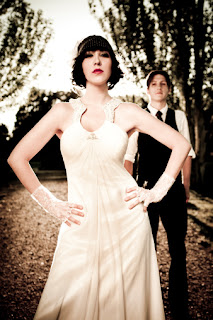Many options are available for brides who would like to wear something other than a traditional white gown. Colour in wedding attire is becomeing much more popular. From light pastels to deep, rich tones, brides can enhance their style and uniqueness by choosing a coloured wedding gown. Certain meanings area associated with different colours.
If you are a bride-to-be considering a coloured wedding dress, let me remind you of the following traditional rather gloomy, rhyme:
,
Married in White, you have chosen right,
Married in Grey, you will go far away,
Married in Black, you will wish yourself back,
Married in Red, you will wish your self dead,
Married in Green, ashamed to be seen,
Married in Blue, you will always be true,
Married in Pearl, you will live in a whirl,
Married in Yellow, ashamed of your fellow,
Married in Brown, you will in the town,
Married in Pink, your spirit will sink.
Variations in length are becoming more common as well. Tea-length gowns have a hemline that sits around knees. This creates a lighter, softer silhouette, particularly for summer and outdoor weddings. Intermission hemlines, with the front of the gown's hemline hitting the knee or mid calf, while the back of the gown drops to the ankle, are a popular and dramatic choice.
For women who have been married before, or those who are a little more mature, trouser and skirt suits are a welcome alternative to a more formal gown. If the bride is not a fan of dresses, a trouser suit can be a very regal alternatice to traditional business suits, wedding suits are created with dressy fabrics and shiney detailing. This variation allows for a simpler, yet feminine and beautiful wedding ensemble.
For brides who love vintage looks, or who are planning a themed wedding based on a previous era, a vintage gown might be the perfect choice. Brides can choose an authentic vintage dress or a vintage-inspired dress. Real vintage gowns can be found at consignment shops or vintage boutiques. Reproductions can be custom-made or found at speciality wedding boutiques.
For brides who are planning a destination wedding, a traditional full-length gown might not be the most comfortable option (or the easiest to travel with!). Whatever attire is chosen, it should be sturdy enough to handle packaging, travel, and any outdoor venues such as tropical and beach destination spots. Ideally, the gown would be light, perhaps short, without a long train, and made of fabric that can easily be steamed free of wrinkles.








